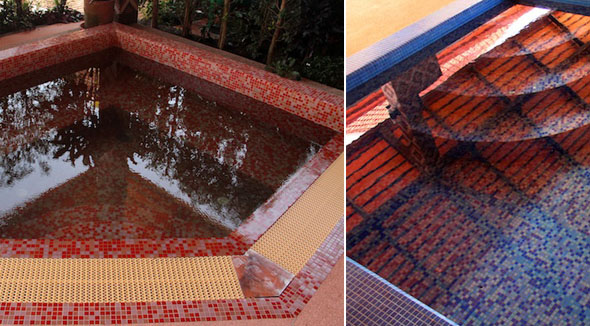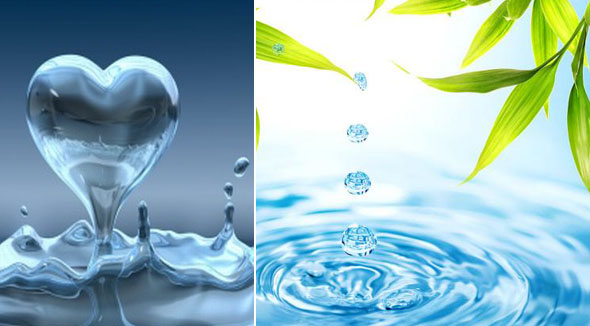Hot and cold pools
During water treatments, the body is subjected to thermal and mechanical stimuli, including the effects of hydrostatic pressure of water that create a buoyant force. How do these factors affect our body, where exactly do the healing qualities of water come from? Once you understand this, you can recognize when, for example, to apply cold water, when to apply hot water, which water procedure to select, the duration of the procedures, and their impact on the body.
Temperature is a crucial aspect in treatment.
On the surface layer of the skin, there are approximately 300,000 cold receptors and approximately 25,000 thermal receptors. Cold or warm water, working on our skin, stimulates the skin receptors, resulting the organism having the reaction of producing or diverting heat. Reflex stimulation of thermoreceptors has an effect on the internal organs.
The process of temperature affecting these receptors can be seen in the following example: following operations on abdominal organs, the patient has an ice pack put to his abdomen. The cold stimulates the cold receptors of the abdominal skin. In the receptors’ nerve fiber an electrical impulse generates, which is transmitted in the centres of the spinal cord, and then to corresponding centres in the barrel and the cerebral cortex. There it stimulates the nerve cells.
As a result of the excitation of the cells in the cortex, a sensation of cold develops—a cold you want to remove, or to move away from. Then, the centre of the spinal cord and stem cells immediately transmit involuntary impulses to the vasomotor nerves. The impulse is applied in the opposite direction to the muscles of vessel walls. Subsequently, the blood vessels contract, less blood enters the skin, the skin becomes paler, and the organism now loses less heat from its surface. However, certain areas of vasomotor centres are connected not only with certain parts of the skin, but also with the vessels located underneath them.
There is a contraction of blood vessels in the centres as well, which is exactly what we need after surgery. Small, spastic vessels, injured after an operation, cease blood flow. On the contrary, upon stimulation of heat receptors of the skin, blood vessels and organs underneath them expand, and blood flow to the relevant organs improves. However, when the temperature is comfortable to the body, a constant monotonous transfer of impulses emits from the thermoreceptors, which does not alter vascular tone.
To maintain health, it is essential that during the life span (especially after the age of 40), thermoreceptors get regularly activated by temperatures beyond comfort in order to evoke response. Afterward, they will function adequately in the case of the disease. Therefore, we must develop the habit of constantly training our body through water treatments.
Stimulation caused by temperature has different effects on the body: low—activates vital functions, medium—strengthens the immune system, excessive—pain
The degree of stimulation depends on what parts of the body are affected, how long they are affected for, when the procedures were conducted, whether they were conducted on a regular basis, and what the difference is between the temperature of water and that of the body. Thus, at relatively high initial body temperatures, cold stimulation is not as unpleasant as when the cold water makes contact with cool skin.
Furthermore, it is necessary that the body produces enough heat, and that during cold exposure the temperature of the internal organs doesn’t drop, which is fraught with inflammatory processes. That is why Dr. Kneipp insisted that his patients warm up their bodies before the procedure, by chopping wood, for example, or with warm water.
Treating the organism with water usually has a certain pattern and accurate dosage. The following characteristics apply to hydrotherapy, and of the water temperature and degree of irritation caused by it:
Temperature Characteristic Stimulation
10-15 oC very cold very strong
16-18 oC cold increased
19-22 oC fresh strong
23-27 oC cool moderate
28-31 oC moderate negligible
32-35 oC indifferent none
36-38 oC warm decreased
39-41 oC hot strong
42-45 oC very hot very strong
The duration of the procedure is also important. For example, a warm bath soothes and relaxes. However, the use of heat to excess (too high water temperature or excessive duration of bathing) can cause the opposite effect: excitement, nervousness and insomnia

In the area where cold water contacts warm skin, cold receptors become activated and a reflex reaction is activated, which results in instantly narrowing minor blood vessels in the surface layer of the skin. Blood is then forced out into the deeper areas of the body. In this part of the body, the skin turns pale. Afterwards, the narrowed vessels expand and the skin becomes red due to a rush of blood, pleasantly warming the body.
If the body is not wiped after the procedure, cold water will be left on the skin’s surface. Due to the rapid heating of the skin, it gradually heats up and evaporates slowly. The skin is cooled again due to evaporation, vessels constrict, and the blood flows away from its surface again; this time it comes back very quickly. Thus, when water evaporates from the skin, blood circulation is actively stimulated.
The reaction to cold water is a good "exercise" for blood vessels, significantly increasing the speed of blood circulation. The course of cold treatments results in more oxygen flowing to organs and tissues through the blood vessels and improving cellular (tissue) respiration. It increases the body’s metabolism and promotes a more rapid excretion of the toxins created by the kidneys, lungs and skin, which strengthens the immune system, alleviating the body from disease. All of the above statements make it clear how cold water heals, and why so many people who regularly resort to competent cold water procedures rarely, if ever, get sick.
Cold water offers a cheerfulness. After a course of water treatment, people feel refreshed and rejuvenated. Doctors at the baths have noted that patients remain in a good mood and become more vigorous, hardy, cheerful, and friendly. The positive effect of water activity on the state of the nervous system is beneficial to the process of recovery from illness.
The most commonly used hydrotherapy procedures are walking in cold water, cold or semi-cold bathing, cold baths for the hands, cold half-body baths, immersion of the legs from the knees or hip, and total immersion.

When hot water affects heat receptors, blood vessels under the skin dilate, causing blood flow to slow down. Then more blood than usual rushes through the dilated vessels, and it streams to the skin, turning it red. This is a protective reaction of the body from overheating. More heat is given off from the blood surging to the skin.
The pores of the skin open, and intensive sweating starts, which is also a defensive reaction—the body releases heat by sweat evaporating from the skin. The vessels of internal organs dilate, improving their blood supply, the blood brings more nutrients and oxygen, swelling resolves more quickly, and inflammation processes stop. Now the body can easily absorb useful herbal or other types of substances penetrating through the skin, which are often added to the water before taking bath to speed up the healing process.
Hot water helps release the body from microbial toxins that suppress the immune system, as well as those of pathogens, regardless of whether they have caused the disease yet or not. Therefore, hot water treatments may anticipate and then suppress disease, preventing its development.
Hot water treatments also contribute to increased stomach and pancreas secretions, improved renal blood flow and improved urinary excretion. Additionally, the heat has a soothing and calming effect, relaxes muscles, and increases the extensibility of connective tissues.
Contrasting water treatment is a great preventative tool, excellently training vessels. The sequential effects of hot and cold water normalize the temperature regulation system, increase the adaptive capabilities of the organism, and temper it. Consecutively directing blood to the skin, then deep into the body, has a positive effect on the microcirculation processes. Moreover, it contributes to normalization of blood pressure, increases myocardial contraction and has a positive (calming) effect on the nervous system.
At the regular conduct of contrast water treatments the skin is cleansed and becomes healthier, allowing it to better carry out its functions—in particular, to remove toxins. Affected by variable temperatures, metabolic processes intensify, improving the function of the urinary, endocrine and other systems.